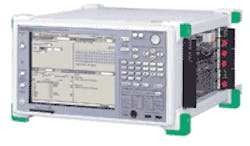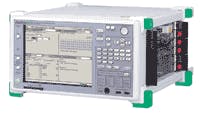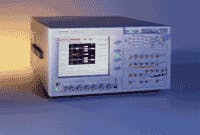Test vendors curb jitter testing stress
Advances in CMOS technology are enabling a new generation of devices in the 5-10-Gbit/sec range, but signal integrity issues and degradations are common at such speeds. Chief among them is jitter, a timing aberration of the incoming signal. Jitter consists of two components: random jitter and deterministic jitter, which consists of periodic jitter (PJ), data-dependent jitter (DDJ), and bounded uncorrelated jitter (BUJ). DDJ includes duty cycle distortion (DCD) and intersymbol interference (ISI).
All of which gets to the heart of the problem, says Michael Droemmer, product marketing manager for Agilent Technologies’ High-Speed Digital Test Division (Palo Alto, CA). “There are simply too many jitter types, too many standards, and too many discussions going on around jitter,” he admits. “And higher speeds cause even more signal problems. The perception, overall, is that jitter is really time-consuming and complex to test.”
XFPs support multiple data rates, including SONET/SDH (9.9 Gbits/sec), OTN (10.7 Gbits/sec), Gigabit Ethernet (GbE) (10.3 Gbits/sec), and Ethernet combined with OTN (11.1 Gbits/sec), and are therefore subject to multiple standards. Today, there are separate standards for jitter testing of 10-Gbit/sec SONET/SDH and G.709 OTN (as defined by the ITU-T) and 10-GbE and Fibre Channel (as defined by the IEEE).
The IEEE 802.3ae standard specifies a stressed eye test to measure the tolerance of the receiver under real world conditions and a BERT scan method to test the jitter output of the transmitter. The ITU-T, meanwhile, has developed standards describing jitter generation, tolerance, and transfer measurements in documents O.172 (SONET/SDH) and O.173 (OTN). The ITU-T O.172 specifications also feature two appendices, VII and VIII, which describe the verification and characterization tools needed to measure the quality of the test set itself; the IEEE standard lacks this verification.
This panoply of standards makes life difficult for device designers. “If I look today to the customers, I see that there are two groups: the transport group looking for telecom and another group looking for Ethernet and datacom,” says Andreas Alpert, product manager at JDSU (San Jose). “Today, customers need two or three test instruments to test all the different parameters because of the different standards. But this has to come together. It’s necessary because in the future you will have a combination of all kinds of interfaces, all kinds of data streams.”
The problem gets even worse since the industry has not yet developed a standard describing Ethernet using OTN, adds Alpert, who notes that it still isn’t clear which group will take on this responsibility. However, he believes it may make more sense for the ITU-T to do so. “O.173 defines the three OTN bit rates, 2.7, 10.7, and 43 Gbits/sec,” he explains. “If you use a mix of OTN and Ethernet, from my point of view, this has to be defined in the ITU-T.”
In an industry in which there are multiple standards requiring multiple tests, the best solution, says Agilent, is to create a test system that does a little bit of everything. The company recently introduced a serial BERT with what Agilent claims are advanced jitter generation capabilities for jitter tolerance testing of serial gigabit devices up to 12.5 Gbits/sec. Dubbed the “J-BERT,” the single-box system provides the functionality of several existing devices, including Agilent’s DCA-J wide-bandwidth oscilloscope, N4901B serial BERT, and E8257 C analog signal generator as well as noise generators, pattern generators, and function generators.Developed in response to customer demand, the J-BERT provides key measurements for both the transmitter and receiver. On the transmit side, the J-BERT performs differential analysis of bit-error rates and random, deterministic, and total jitter. On the receive side, it performs calibrated jitter injection, automated jitter tolerance, and ISI and stressed eye tests.
Automation is critical, says Droemmer, who notes that many of Agilent’s customers were developing their own codes to create automated test suites, a time consuming process. Having automated jitter characterization built-in will enable them to get to market sooner with standards-compliant devices. “There’s a customer I speak with quite frequently down in Texas, and they usually say, ‘If we’re late on the market with one of our designs, we’d rather skip it. We’d rather not do it,’” recalls Droemmer. “If you’re among the early suppliers on the market, you can get the better deals, the higher-margin deals. But if you’re late on the market-at least, later than the others-you will have to make compromises on your prices.”
Anritsu (Richardson, TX), meanwhile, tackled the problem of XFP jitter testing earlier this year, unveiling a 10-Gbit/sec differential I/O feature for its existing MP1590B network performance tester at SuperComm last June. The MP1590B provides performance tests and jitter measurements of SONET/SDH, G.709 OTN, Ethernet, and Ethernet over SONET. The test system also supports ITU-T O.172/O.173 jitter analysis up to 10.7 Gbits/sec.
According to marketing communications manager Jack Landau, the upgraded MP1590B was the first single-box device for differential electrical jitter testing of 10-Gbit/sec XFP modules. The XFP multisource agreement specifies the measurement of jitter tolerance at electrical differential interfaces, but existing test equipment could not accurately measure both the optical interface and electrical differential interface, known as the XFI. Existing devices were adequate for basic performance, says Landau, but they were not suitable for sophisticated jitter testing. The newly added differential I/O function enables users to perform jitter measurements on both the transmit and receive sides.
The MP1590B is applicable up and down the food chain, adds Landau. Carriers and service providers will use the new device to qualify their switches and routers in the lab, while system manufacturers will use the instrument to test the quality of the XFP modules they integrate into their systems. Design engineers represent the largest market and will use the MP1590B to verify that their XFP devices conform to all standards and specifications regarding jitter.
“What really bothers people is ‘How much margin do I have?’” muses Agilent’s Droemmer. “‘How can I optimize my test to achieve optimal yields? How can I squeeze my characterization time in the lab to a minimum to get faster to market?’ This is all about getting faster to market.”
Agilent and Anritsu face stiff competition from those already in the market, including Tektronix (Beaverton, OR). In August, the company introduced new sampling oscilloscope software that enables designers to validate and characterize electrical and optical components and computer circuits, backplanes, and interconnects for data rates from 1 to 60 Gbits/sec. Designed for use with its 8000 series sampling oscilloscopes, the new software performs advanced BER, noise, and jitter analysis, including measurements of random, deterministic, periodic, and data-dependent jitter as well as duty cycle distortion.
SyntheSys Research (Menlo Park, CA) meanwhile recently launched the BERTScopeS, an upgraded version of its flagship BERTScope. Like Agilent’s J-BERT, the BERTScopeS combines the features of a high-speed BERT, sampling scope, stressed eye generator, and jitter analyzer in a single box to improve designers’ time-to-market. The newly upgraded BERTScopeS also provides compliance tests for XFP/XFI interfaces.Meghan Fuller is the senior news editor at Lightwave.


